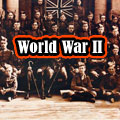Home | Living With War | Social Changes for Albertans | Here Come the Yankees!
Here Come the Yankees!
Known as the “friendly invasion”, thousands of British, American, and Australian military personnel resided in Alberta during the Second World War. Americans were predominant in the Edmonton area. It is estimated that as many as 48,000 American soldiers and civilian contract employees lived in and around or passed through Alberta’s capital during the Second World War.
Following the Japanese attack on the American Pacific Fleet at Pearl Harbor in December 1941, United States government and military officials developed plans for the fortification and defence of Alaska and parts of northern Canada. These plans precipitated the development of a series of projects, including the construction of the Alaska Highway, the CANOL Pipeline and the Northwest Staging Route. Edmonton became the key southern transport and supply depot and administration centre for most of these projects.
 Reacting to the perceived threat of invasion against the North American continent via Alaska, the Americans dispatched thirty-eight military aircraft to Fairbanks. Taking off from Edmonton in January 1942, eleven of these airplanes crashed in the remote wilderness of north-west Canada. In the wake of the accidents, the Americans proposed the construction of the Alaska Highway as a means of combating shoddy landing strips, poor weather and a lack of navigational markers. The Northwest Staging Route (NWSR), a chain of landing fields complete with emergency lighting, weather stations, and radio transmitters, was deemed ineffective.
Reacting to the perceived threat of invasion against the North American continent via Alaska, the Americans dispatched thirty-eight military aircraft to Fairbanks. Taking off from Edmonton in January 1942, eleven of these airplanes crashed in the remote wilderness of north-west Canada. In the wake of the accidents, the Americans proposed the construction of the Alaska Highway as a means of combating shoddy landing strips, poor weather and a lack of navigational markers. The Northwest Staging Route (NWSR), a chain of landing fields complete with emergency lighting, weather stations, and radio transmitters, was deemed ineffective.
President Franklin Delano Roosevelt allocated $10 million for a prospective survey and the development of engineering plans for the construction of an international highway. Citing high costs, Canadian officials were hesitant to pursue the project. Prime Minister King’s government allowed the project to proceed when the US government agreed to cover construction costs for the Alaskan Highway. The highway stretched from Dawson Creek, British Columbia to Fairbanks, Alaska, traversing the northeast corner of British Columbia and the southwest portion of the Yukon Territory.
Thousands of American military personnel - engineers and general labourers – began arriving in Edmonton in February/March 1942. This was the beginning of the "friendly invasion" of Edmonton.
The Americans brought with them 904 tractors, 2,700 dump trucks, and 174 steam shovels. Of the 11,000 men who laboured on the Alaska Highway, one-third were soldiers of African-American heritage. They were segregated from their fellow white soldiers, both on railway cars and in camps, and they were not allowed to patronize local establishments for fear local residents would resent their presence.
The final cost of construction of the 2,605-kilometre (1,619-mile) highway was $148 million Canadian. The difficulty of building a road through mountainous terrain was compounded by severe cold in the winter and hordes of insects in the summer. Also, American engineers faced substantial challenges having had little experience in the Canadian climate and due to a general lack of preparedness. Among these was building a road over permanently frozen terrain. Disturbing Permafrost in an effort to build a solid road base led to a rapid breakdown of subterranean levels due to melting ice.
Despite the many challenges, the road was completed in nine months. The official opening of the Alaska Highway took place on November 20, 1942 and was attended by Canadian and American officials. The ceremonies were conducted at Soldier’s Summit, Alaska in – 37 degree Celsius (-35° Fahrenheit) temperatures.
The construction of the Alaska Highway fostered good relations between the United States and Canada. The American press praised Canadians and the citizens of Edmonton in particular for their commitment to the war effort. When the city was hit by a major blizzard in November 1942, senior American military personnel in the region ordered troops to aid in the clean up; all available road equipment was deployed to clear city streets. The incident solidified an already budding relationship between citizens and guests.
References
Mandel, Charles. “Fear of a Japanese Attack brings the U.S. Army to Alberta and B.C.”, Alberta in the 20th Century, ed. Ted Byfield (Edmonton: United Western Communications, 2000), 162–173.
Macleod, Rod. “Edmonton's Story: War and Oil: 1940-1972.” Edmonton: A City Called Home, 2004, Edmonton Public Library (accessed October, 2007).








